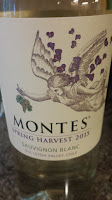This statement was the basis for a virtual tasting of six Chilean coastal Chardonnay and Pinot Noir wines presented by Wines of Chile and Joaquin Hidalgo, wine columnist for La Nación,"Of the great oceanic currents, the Humboldt stands out. It generates one of the richest maritime ecosystems in the world. It’s so large and cold that it affects the coasts of South America from the 50th to the 4th parallels. And, whenever it shifts course the impact on weather patterns is global. So potent is the Humboldt that it’s no wonder that any wines grown on its doorstep are affected accordingly."
During the presentation he informed us that , "due to its scale and length, the Humboldt Current changes the weather around it, creating a cold buffer in nearby air masses and lowering temperatures as it goes. Even in tropical regions, the resulting lack of evaporation, due to the cooler temperatures, makes for a decisive drop in atmospheric humidity. " How so? "Firstly, it cools the water over the sea, generating a classic thermal inversion in summer, condensing the little humidity generated during the day and, from the early morning right through to midday, creating a thick fog that spreads over the sea and coast. It’s the same kind of mist famously seen in California’s Sonoma Coast and the Santa Lucía Highlands, just on a larger scale. Because this fog also filters the sunlight, grape varieties with short ripening cycles, mainly Chardonnay, Sauvignon Blanc and Pinot Noir, develop slowly and delicately."
"This combination of cool temperatures and ample sunlight ensures that the wines ripen fully but gradually. While the whites retain sharp acidity and low pH, the fruity aromas tend to be ripe -- apple and pear for Chardonnay with notes of lime and ginger, and the palates are rich in spite of the tart core. For Pinot Noir, the color is slightly more vivid due to the impact of the sunlight, while the crisp aromas of sweet and sour cherry are accompanied by wet earth, a hint of blood, tart acidity and a rich palate."The Humboldt effect also presents some problems. The closer to the Ocean, the more intense the moderating effect on temperature and fog becomes, thus frost rises as a concern. To alleviate this risk, vineyards are planted facing North to capture as much sunlight as possible. And since temperatures barely change across variations in latitude, there is a delicate balance between the grapes planted and the appropriate micro-climate. These "pockets"; such as San Anontio, Lo Zarate, Colliguay, and Isla de Maipo; are where the wines we tasted are grown.According to Hildago, these pockets are well suited for Chardonnay and Pinot Noir. Chardonnay delivers green apple and pear, with notes of lime and ginger; flavors are rich, in spite of the tart core. Whereas Pinot Noir offers a slightly more vivid color due to the impact of sunlight. Crisp aromas of sweet and sour cherry are accompanied by wet earth, a hint of blood, tart acidity and a rich palate. In addition, calcareous clay soils in Limarí bring a chalky feel to Chardonnay and Pinot Noir as seen in the wines from Miguel Torres, Viña Concha y Toro, and Santa Rita. On the other hand, abundant granite soils in Chile’s Coastal Range lead to lean, smooth textures, particularly in Pinot Noir. See the TerraNoble and Viña Garcés.Viña Montes Alpha Chardonnay Chile 2022
Aroma of tropical fruit then candied papaya; toasty, red apple, and vanilla.
Santa Rita Chardonnay Floresta Chile 2021
Yeasty floral; pears and pineapples, saline, good acidity, creamy texture.
Miguel Torres Cordillera Chardonnay Chile 2023
Floral; salinity and acidity - lots of ripe apple and lime - chalky from clay soils.
Viña Garcés Silva Boya Pinot Noir Chile 2020
Raspberries and roses on the nose; red currants (tart) and herbaceous; fresh acidity - light tannins.
Viña Concha y Toro Amelia Pinot Noir Chile 2022
Nice mouthfeel. Soft red fruit on nose, tea, chalky, some black pepper & saline, lingering finish.
TerraNoble Algarrobo Pinot Noir Chile 2023
Sour cherry puree on nose; continues on palate, wet stone earthiness, structure, acids, lasting finish.











